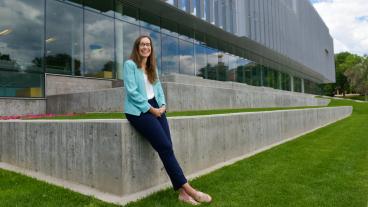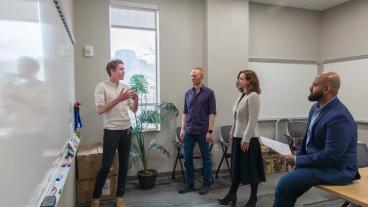 For PhD student Alyssa Allende Motz, physics is not just about learning how matter moves through space and time or the complicated laws that govern our understanding of energy and force. She says that physics is more about “teaching you how to learn and how to think of things so that you can make more conclusions that lead you to more questions.”
For PhD student Alyssa Allende Motz, physics is not just about learning how matter moves through space and time or the complicated laws that govern our understanding of energy and force. She says that physics is more about “teaching you how to learn and how to think of things so that you can make more conclusions that lead you to more questions.”
Allende Motz is not new to the world of physics. She earned her bachelor’s degree in engineering physics in 2011 and her master’s degree in applied physics in 2012, both from Mines. But she decided to return to Mines to pursue a PhD, because she wanted to continue searching for answers. “The more you find out,” she says, “the more you find out that you don’t know.” And she speaks from experience.
She regularly works with nonlinear optics and nonlinear microscopy, or, in other words, focusing a laser beam to a very small point to the diffraction limit of light to get high-resolution imaging. “In my research, we wanted to push the resolution limits, and we thought this really wouldn’t change the scope of something called a lifetime measurement,” she says. “What we found out was that at first what appeared to be lifetimes that looked incorrect was actually a feature of the measurement being different from the macroscale measurement. It actually led to more questions. But then more was found out with the same kind of measurement, just on a different kind of scale.”
Allende Motz’s research in particular focuses on photovoltaics, which generate electricity directly from sunlight. Specifically, she deals with a technology called thin-film photovoltaics, which she explains is a promising technology because of its potential to be an inexpensive energy resource while also being effective. But researchers are still working out a few questions in the lab. “There’s a theoretical efficiency of these solar cells, and we’re not quite hitting that theoretical efficiency,” Allende Motz explains. “And we’re not quite sure why yet.”
She says the reason for this inefficiency is most likely due to grain boundaries—defects in a crystal structure that tend to decrease the electrical and thermal conductivity of the material. “These grain boundaries are only 50 nanometers or so wide, so you have to have a very high-resolution system to study the nature of these grain boundaries and how they interact with the material and how they affect solar cell efficiency; specifically, what is leading the degradation,” Allende Motz says. She aims to develop a microscope that will have a high enough resolution to determine the physics of grain boundaries and learn more about improving the efficiency of thin-film photovoltaics.
 The end goal of this technology? To make solar cells that are inexpensive enough and produce enough electricity to make them market competitive with fossil fuels. And although she isn’t directly involved with making these solar cells, her work is just as important. “We don’t make the materials,” she says. “But we make the tools that characterize the materials.”
The end goal of this technology? To make solar cells that are inexpensive enough and produce enough electricity to make them market competitive with fossil fuels. And although she isn’t directly involved with making these solar cells, her work is just as important. “We don’t make the materials,” she says. “But we make the tools that characterize the materials.”
But Allende Motz’s research isn’t limited to energy-related applications. “I have this idea of studying neurons with something similar to excitons, which is basically the movement of charge. So you could study the movement of charge through neurons, and maybe that could help study things like Alzheimer’s,” Allende Motz says.
There are clearly many benefits to her research and the technology she is developing. “We try to find problems that need solutions,” she says. “What I hope to do with this microscope once I complete my research, is apply for some sort of postdoc grant and continue study with it. I want to show the versatility of the instrument by studying different samples besides just PV, like biological samples.”
While her research answers many questions, Allende Motz isn’t intimidated by the questions that it also uncovers. “I like it, because I get to do something that I feel is creative and artistic, and it’s also applicable to something concrete and realistic,” she says. “We’re discovering new things about materials that are going to help researchers find better materials in the future.”
Contact:
Ashley Spurgeon, Editorial Assistant, Mines magazine | 303-273-3959 | aspurgeon@mines.edu
Mark Ramirez, Communications Manager, College of Applied Science & Engineering | 303-384-2622 | ramirez@mines.edu



